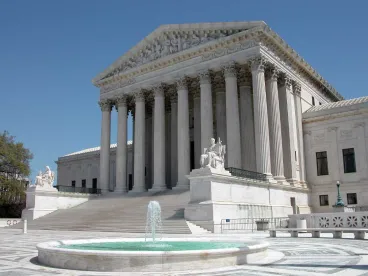With essential unanimity, though with an array of concurrences in one of them, the Supreme Court ruled against government parties in three cases, two of them in favor of homeowners, and in property rights and environmental enforcement cases, and a third, upholding the right of appeal by a prison guard charged with causing a detainee’s beating.
Tyler v. Hennepin County, Minnesota involved the owner of a condominium, Geraldine Tyler, who had accumulated about $15,000 in unpaid real estate taxes, along with interest and penalties. Pursuant to a Minnesota statute, the County seized the condo and sold it for $40,000, keeping the $25,000 excess over Tyler’s tax debt for itself. Tyler filed suit, alleging that the County had unconstitutionally retained the excess value of her home in violation of the Takings Clause of the Fifth Amendment and the Excessive Fines Clause of the Eighth Amendment. Reversing the dismissal of her case, a unanimous Supreme Court agreed with Tyler, holding that she has standing to claim that Hennepin County’s retention of the excess value of her home above her tax debt violated the Takings Clause. Calling this a “classic pocketbook injury” and relying upon a principle of Anglo-American law dating back to the Magna Carta, the Chief Justice reiterated that a government may not take from a taxpayer more than she owes.
The Court also rejected the County’s argument that it was permitted to act because there were remaining debts on Tyler’s home. Even if that were so, the $25,000 that the County retained could have been used to address her debt. In sum, Tyler has stated a claim under the Takings Clause, which provides that “private property [shall not] be taken for public use, without just compensation.” While state law is an important source of property law, it is not the only source. Here, the U.S. Constitution predominates.
Sackett v. Environmental Protection Agency is another case in which property owners prevailed, this time against the federal government. The Sacketts were purchasers of an Idaho property who had begun backfilling their lot with dirt in preparation for building a home. The EPA informed the couple that their property contained wetlands and that their backfilling violated the Clean Water Act (CWA), which prohibits discharging pollutants into “the waters of the United States.” 33 U. S. C. §1362(7). The Sacketts were threatened with penalties of more than $40,000 per day unless they restored the lot. The EPA’s assertion that the lot could be classified as “waters of the United States” rested on the fact that it lay near a ditch that fed into a creek, which fed into Priest Lake, a navigable, intrastate lake. In holding against the Sacketts, who had challenged the EPA, the Ninth Circuit had held that the CWA covers wetlands with an ecologically significant nexus to traditional navigable waters and that the Sacketts’ wetlands satisfy that standard. In an opinion joined by all of the Justices, various combinations of whom also concurred, Justice Alito, applying a strict textual analysis, wrote for the Court that the CWA’s use of “waters” in §1362(7) refers only to “geographic[al] features that are described in ordinary parlance as ‘streams, oceans, rivers, and lakes’” and to adjacent wetlands that are “indistinguishable” from those bodies of water due to a continuous surface connection. Thus, to assert jurisdiction over an adjacent wetland under the CWA, the EPA must first show “that the adjacent [body of water constitutes] . . . ‘water[s] of the United States’ (i.e., a relatively permanent body of water connected to traditional interstate navigable waters); and second, that the wetland has a continuous surface connection with that water, making it difficult to determine where the ‘water’ ends and the ‘wetland’ begins.” In short, the definition of a “wetland” depends upon its objectively determinable physical characteristics, not upon an abstract argument concerning environmental effects.
Sackett is not an unimportant case. Besides its immediate effect on the enforcement policy of the EPA and the arguments of environmental activists, the case is another significant limitation on the deference that the Supreme Court will afford to an administrative agency. Here, all the Justices agreed that the EPA’s interpretation could not stand in the wake of precedent and statutory language. In West Virginia v. EPA, where the EPA also was given no deference, Justice Kagan might have disowned her previous statement that “[w]e all are textualists now.” However, in this case, all the Justices were just that.
Finally for the day, Dupree v. Younger is yet another case in which an individual prevailed against the government, and on procedural grounds that are important with respect to the broad question of when a case may be granted appellate review. Kevin Younger sued Neil Dupree under 42 U. S. C. §1983, claiming that while in pretrial detention in a Maryland state prison, he was beaten by prison guards upon the order of Dupree, their lieutenant. Prior to trial, Dupree moved for summary judgment under Federal Rule of Civil Procedure 56(a), arguing that Younger had failed to exhaust administrative remedies. Rule 56, as is well known by practitioners, mandates a district court to enter judgment on a claim or defense if there is “no genuine dispute as to any material fact and the movant is entitled to judgment as a matter of law.” Here, the lower court denied Dupree’s motion, finding that there was no dispute that the state had conducted an internal investigation that satisfied the exhaustion requirement.
The case was then tried with Dupree presenting no evidence related to his exhaustion defense. Both he and the four guards he directed were found liable for $700,000 in damages. Dupree did not file a post-trial motion under Rule 50(b), which allows a losing party to file a renewed motion for judgment as a matter of law. Instead, he appealed to the Fourth Circuit on a single issue: the District Court’s rejection of his exhaustion defense. The Court of Appeals was bound by its own precedent to rule against him on the grounds that a claim or defense rejected at the summary judgment stage is not preserved for appellate review unless it was renewed in a post-trial motion. In an opinion for a unanimous Court, Justice Barrett rejected the Fourth Circuit’s disposition of the case, holding that a post-trial motion under Rule 50 is not required to preserve for appellate review a purely legal issue resolved at summary judgment. Such an order might not be immediately appealable, but it is ultimately reviewable under 28 U. S. C. §1291. Thus, the case was remanded for a determination as to whether the issue in dispute was a purely legal one.
There still are more than 30 cases pending decision by the Court, a few of them likely to be far more contentious than the frequent unanimous opinions thus far handed down this term. So, stay tuned.




 />i
/>i

